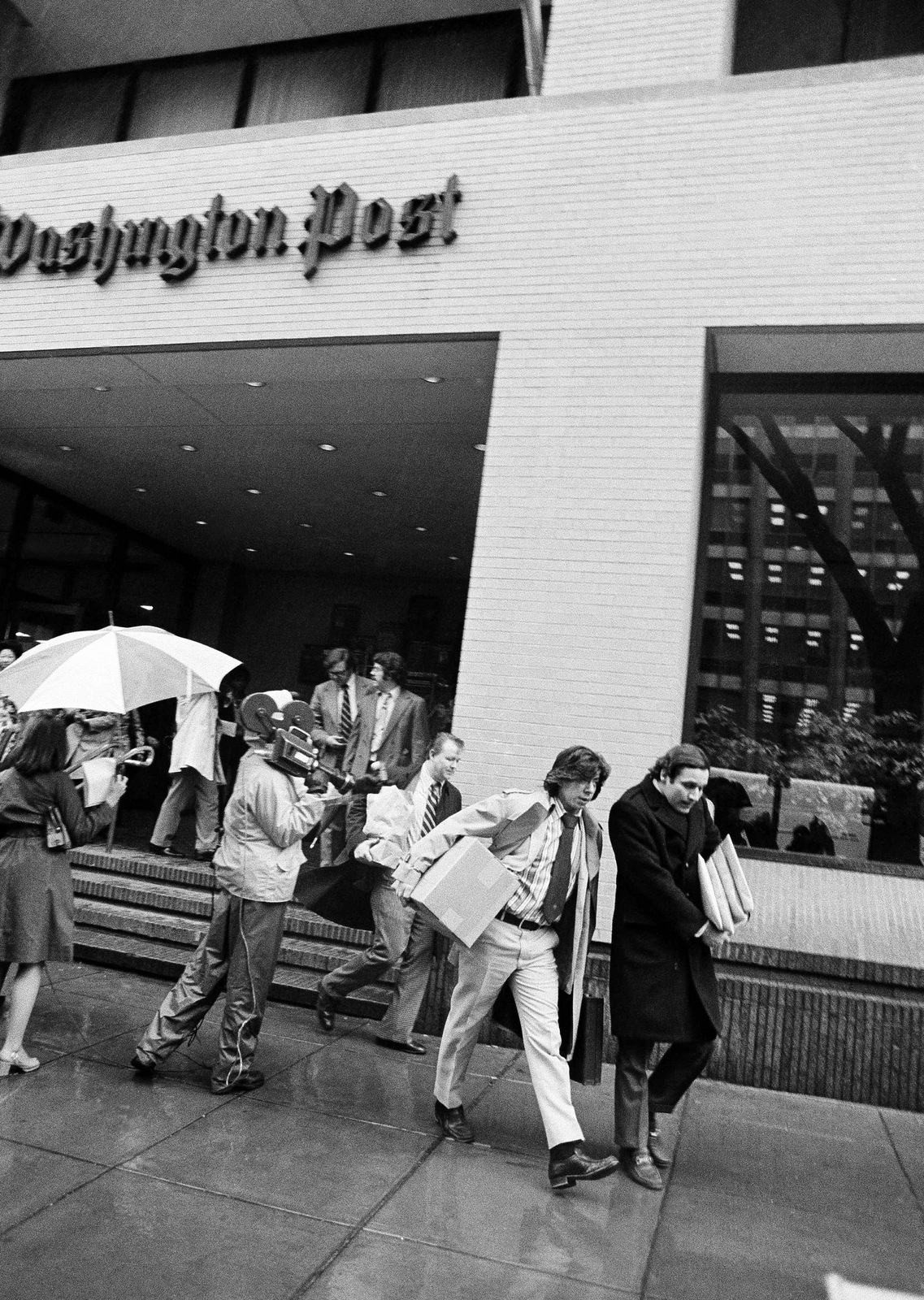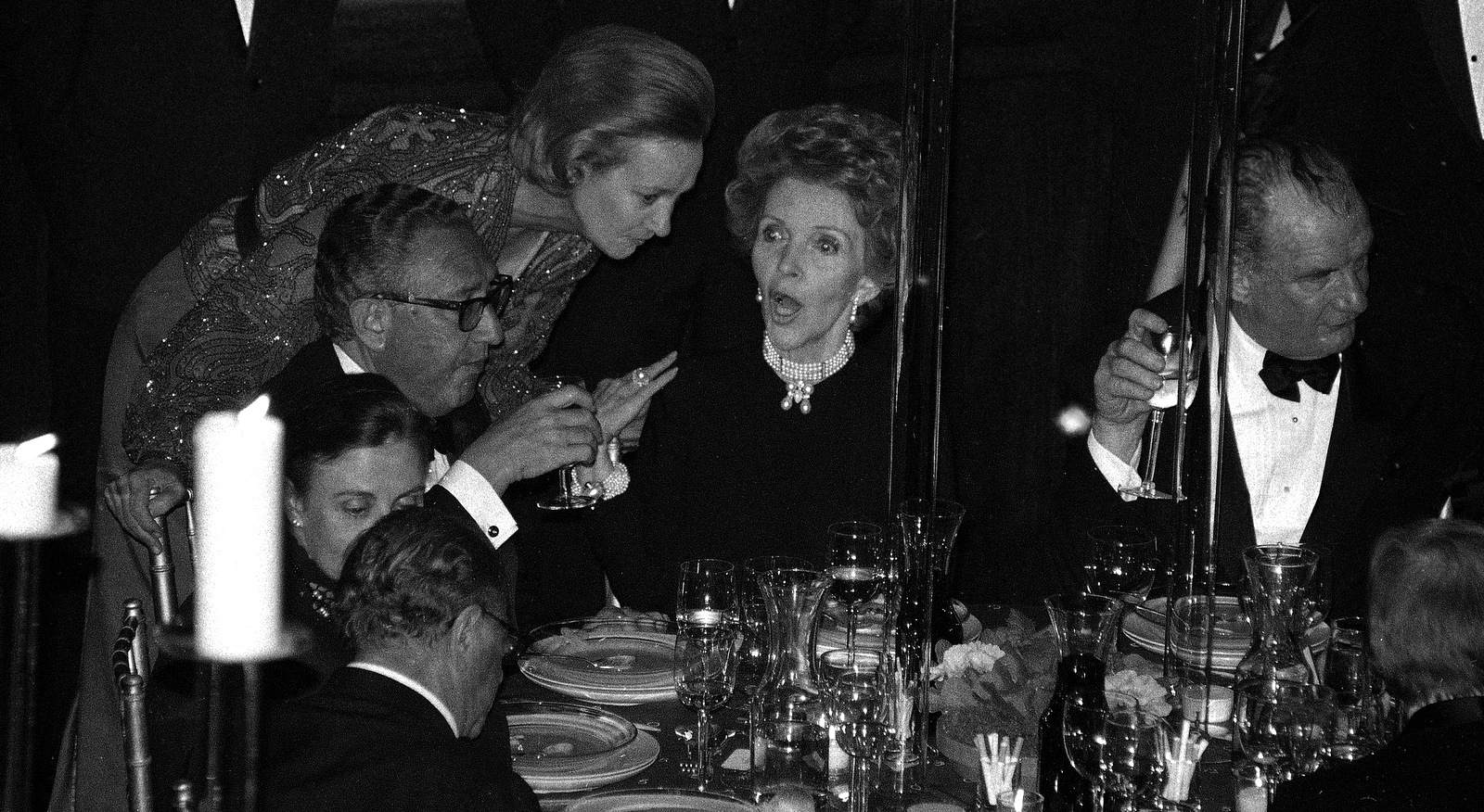Washington Post reporters Carl Bernstein and Bob Woodward, who uncovered the Watergate scandal, along with other editorial employees, walk off the job at the Post in Washington, after Baltimore-Washington arm of the American Newspaper Guild struck the paper, April 8, 1974. (AP Photo)
WASHINGTON (Opinion) — Meryl Streep received her 21st Oscar nomination last week for her portrayal of Katharine Graham in Steven Spielberg’s thriller, The Post. The film depicts the iconic newspaper publisher and her storied editor, Ben Bradlee (played by Tom Hanks), staring down a ruthless Nixon administration and cautious shareholders to print the secret government study that put paid to the official lies undergirding the Vietnam War, in an act of heroism that saved the Fourth Estate if not American democracy itself.
Talk about fake news.
“If you’re not careful,” Malcolm X once said, the media’s preoccupation with folkloric narratives that romanticize the rich and the powerful “will have you hating the people who are being oppressed, and loving the people who are doing the oppressing.” The Post is damning evidence in support of Hollywood’s class bias — for Graham and Bradlee did indeed have a lasting impact on both journalism and democracy, but not in a good way.
From freedom of the press to firing of the pressmen
Far more transformative than The Washington Post’s 1971 publication of the Pentagon Papers was a work stoppage by the Post’s 200 pressmen that began four years later in the wee morning hours of October 1, 1975. When it was over 10 weeks later, Graham had crushed Local 6 of the Newspaper and Graphic Communications Union, replaced the fired pressmen with non-union scabs, inspiring her friend Ronald Reagan to do the same to 11,345 striking federal air traffic controllers six years later, which introduced a new era of labor docility that produced offshored jobs, shrinking wages, and yawning inequality.

The 1975 pressman’s strike represented not only the twilight of the American working class but of journalism as well. In her zeal to maximize profits for the Washington Post Company’s new shareholders, Graham is as responsible as any media mogul for reshaping reportage to meet investors’ narrow and elitist tastes, leading to a “fake news” environment today that is obsessed with allegations of Russian interference in the 2016 election, while almost entirely ignoring the perfect economic and political storm that is bearing down on the global economy.
Graham herself seemed cognizant of her true legacy, devoting 50 pages to the pressman’s strike in her 1998 memoir Personal History, or nearly double the number of pages exploring her decision to publish the Pentagon Papers. In the Pulitzer-prize winning autobiography, she describes being blindsided by Local 6, which disabled all nine presses before their walkout and “brutally” beat a pressroom foreman who’d tried to inspect the damage. Writing in the same self-ennobling language that characterizes Spielberg’s film, she writes that she was awakened by a phone call from one of her negotiators at 4:45 a.m:
There was no time to think. I dressed hastily, jumped in the car without waking my driver who lived nearby and drove myself down quiet and dark Massachusetts Avenue to 15th Street.”
Central to Graham’s defense was the union’s damage to the presses, which the Post, at one point implied approached $15 million, or nearly $70 million in today’s dollars. Post executives later agreed to a sum of about $270,000, and there is evidence the damage was far less than that figure even. An enterprising Chicago Tribune reporter called the company hired to manage the repairs and was quoted a figure of $12,900.
The truth of the matter is that the Post had been preparing “for a strike for two years,” wrote the newspaper’s former national editor, Ben Bagdikian — who supervised coverage of the Pentagon Papers and was later the dean of the journalism program at the University of California at Berkeley — “sending 125 management people to a training center to take over union duties, and setting up alternative composing equipment in a secret project on the paper’s executive floors.”
Elevating the bottom line
The reason was simple: money. Those same shareholders who failed to convince Graham to bury the Pentagon Papers when the Washington Post Company first went public in 1971, ruled the roost by 1975. The newspaper’s overall financial health was sound, with revenues soaring to $122 million in 1974, up from $84 million three years earlier. Profits stood at $10.9 million, or a robust 9.1 percent, but investors pushed Graham to restore profit margins to their 1969 level of 15.1 percent.
“The first order of business at The Washington Post is to maximize the profits from our existing operations,” Graham told security analysts in January 1972. “Some costs resist more stubbornly than others. The most frustrating kind are those imposed by archaic union practices . . . This,” she concluded, “is a problem we are determined to solve.”
The pressmen overwhelmingly rejected the Post’s final offer. Said Local 6 leader, Jimmy Duggan: “To have accepted that final offer would have meant there was no union. There was no doubt in my mind the Post wants to bust its unions.”
Graham acknowledged as much in a conversation with a family friend, the conservative AFL-CIO President George Meany, who asked her in the strike’s final days what she would do if the pressmen accepted her final offer. “I guess I’d slit my throat from ear-to-ear,” was her response.
The backlash against “socialism,” the New Deal, and racial progress

Washington Post publisher Katharine Graham, center, speaks with first lady Nancy Reagan, right, and former U.S. Secretary of State Henry Kissinger, during a gala celebrating the 50th anniversary of Newsweek magazine, Feb. 7, 1983, in New York. (AP/Ray Stubblebine)
To understand how integral the pressman’s strike was to reshaping labor relations and the New Deal’s Keynesian compact between management and workers, it’s important to contextualize the period in which it occurred. Graham succeeded as the Post’s publisher both her father and her late husband, Phil, both of whom had good relations with the newspaper’s’ craft unions. But as Japan and postwar Europe began to challenge the country’s manufacturing dominance in the late 1960s, and aggressive trade unions began to demand an increasingly larger share of the national Gross Domestic Product, investors began to worry that the U.S. was becoming another social democracy.
The same year as the pressman’s strike at the Post, Wall Street effectively staged a coup in New York City, marginalizing militant public sector unions to redirect taxpayer money away from the commonwealth, and into creditors’ bank accounts.
And, of course, race played a vital role in both Wall Street’s takeover and the Post’s union busting. To combat New York’s most militant labor activists, African-Americans, Wall Street executives wooed white labor leaders by depicting blacks as selfish and even unpatriotic. Similarly, Graham managed to isolate Local 6 by portraying the union as a kind of racial bubble in a city that was, at the time, two-thirds African-American.
“The pressmen were all-white,” Craig Herndon, a black former Post photographer who started at the newspaper in 1968 and refused to cross the picket line told MintPress:
A lot of those guys lived in West Virginia and they would drive into town for the week, and then go back home on the weekends, and that cost them a lot of support in Chocolate City. There just wasn’t a lot of support for them either in the newsroom or at City Hall.”
Graham cynically boasted that the first scab hired was a black man, though the Post was never viewed as an ally of the District’s black community, and at the relationship’s nadir in 1981 published a fabricated profile of an eight-year old black heroin addict. That same year Graham’s friend, President Ronald Reagan, fired 11,345 striking air traffic controllers represented by the Professional Air Traffic Controllers Organization (PATCO), which was a shot across the bow in America’s class war. Reagan’s handling of the labor dispute signaled to private industry that there was a new sheriff in town and, in this new arrangement, organized labor was persona non grata.
Moreover, Bagdikian wrote a month after the strike concluded in the January 1976 issue of The Washington Monthly, the Post’s redoubled emphasis on the bottom line exemplified “a crucial change in American newspapering,” and reflected the “transformation of the daily newspaper in the United States from a family enterprise to a corporation with an obligation to its stockholders to ‘maximize’ profits.”
That tension has had a profound influence on today’s media, and is a principal factor in journalism’s myopic scrutiny of Russian political interference.
Cynicism up close and personal
On a personal note, the 1975 strike has bookended my own journalism career. When I was a young City Hall reporter at the Minneapolis Star Tribune in the early 1990s, the city’s liberal mayor summoned me into his office one morning and recounted an interesting conversation he’d had recently with the newspaper’s publisher, Roger Parkinson, who’d arranged for helicopters to transport typeset pages to printing presses while a Post executive during the 1975 strike.
“[Roger] asked me if there’s any way to get around the city ordinance forbidding private helicopters from landing on city buildings, the mayor said.
The Star Tribune was about to enter into negotiations with the newspaper guild, of which I was a member.
“I told him that there was not,” the mayor continued with a sly smile. “I told him that the law was in place to prevent shenanigans like the one the Post pulled to break the pressman’s union. He didn’t seem happy with that answer.”
Years later in 2004, almost a decade before Amazon founder Jeff Bezos purchased the paper, I was a foreign correspondent for the Post, when editors held a series of stories I’d written about Argentina’s debt crisis and the growing national consensus that the government should default because the debt owed to foreign bondholders was largely illegitimate. I was floored: in more than a decade at the paper, I’d never before so much as had a single, completed story go unpublished. In my last 18 months, editors had refused to publish easily a half-dozen articles.
I was telling this to an Argentine economist when he stopped me mid-sentence. “Jon,” he asked, “don’t you think it’s possible that [Postshareholder] Warren Buffett or some other Post shareholder, owns some of Argentina’s paper [i.e., debt] as well, and they don’t want to see any talk of ‘default’ in a newspaper that they partially own?”
I quit the Post a year later.